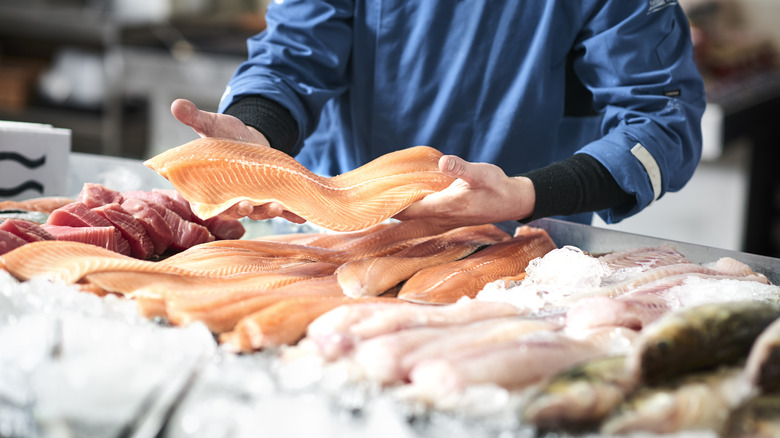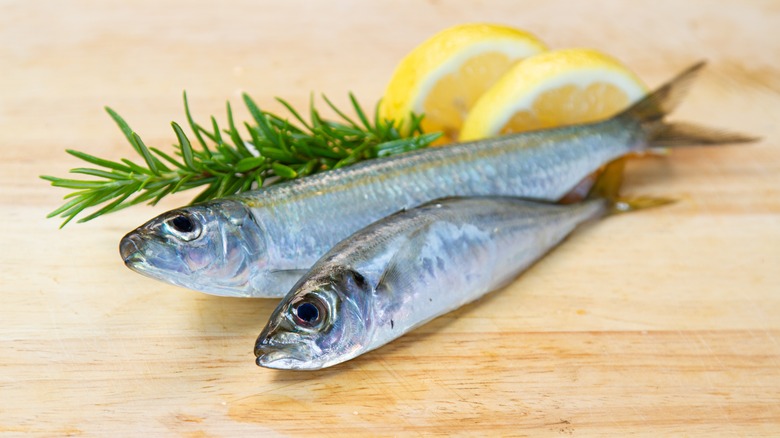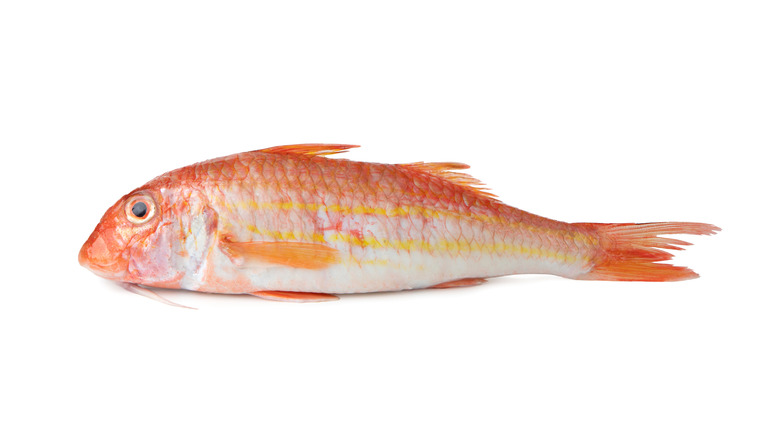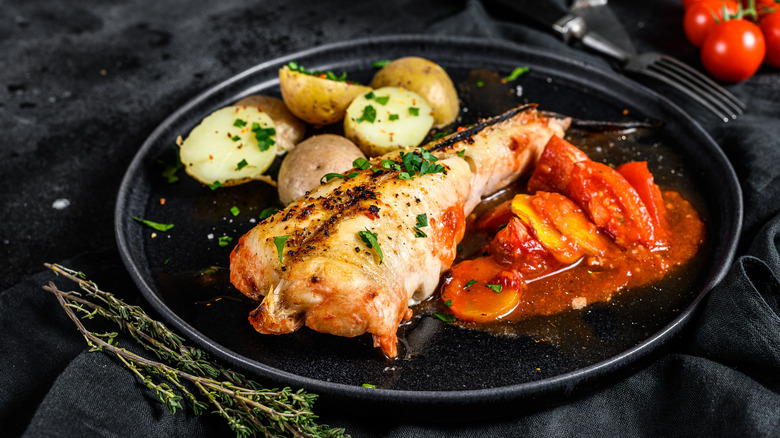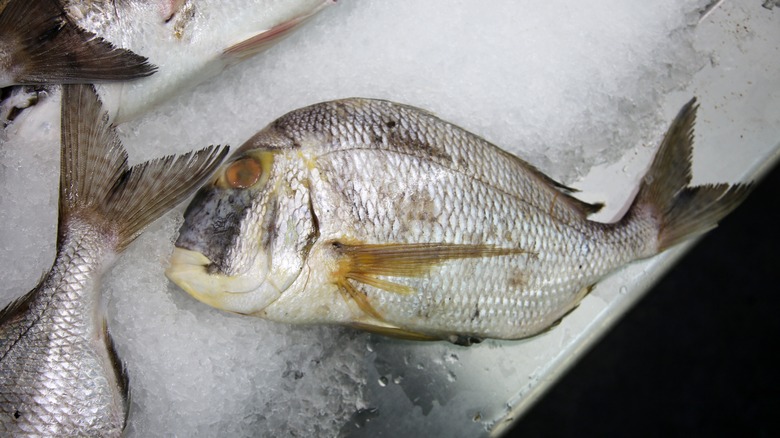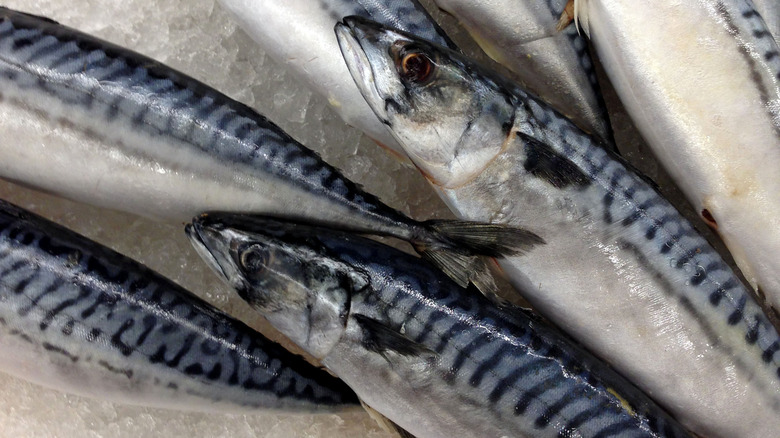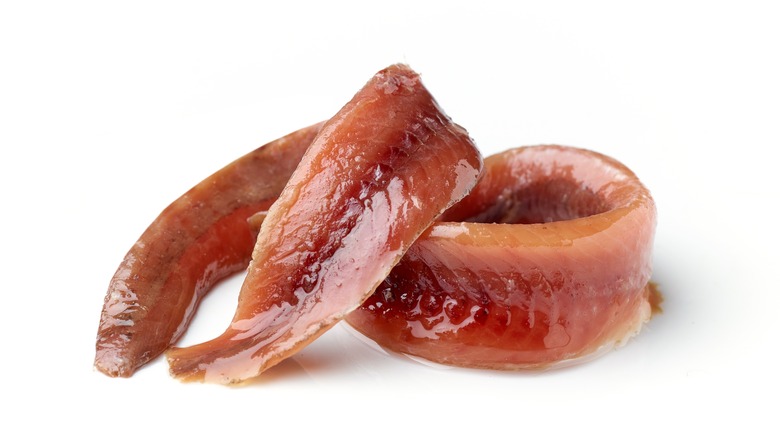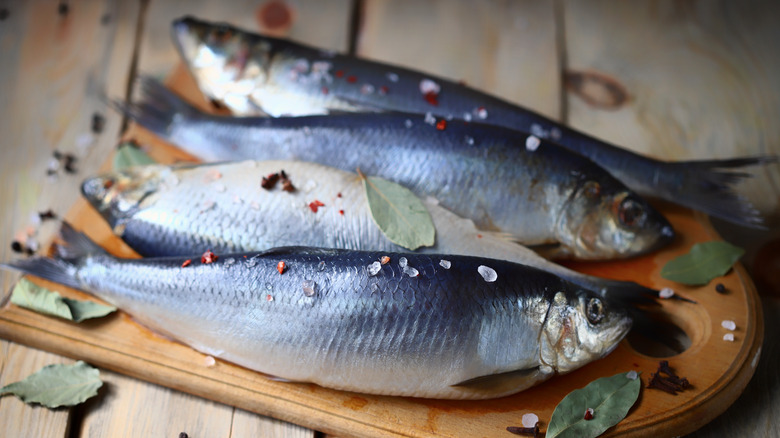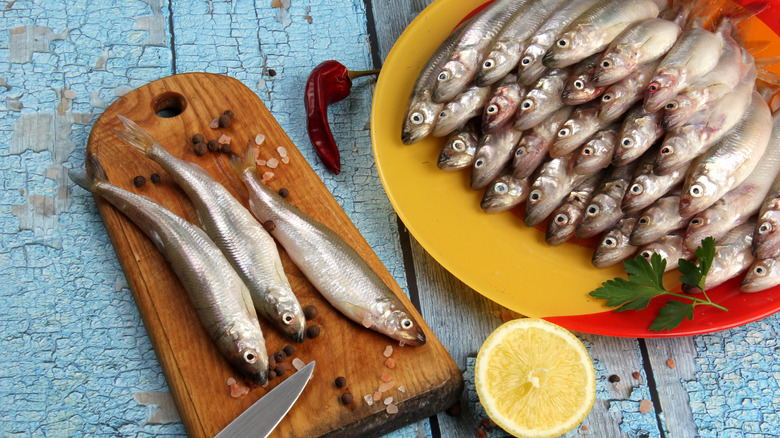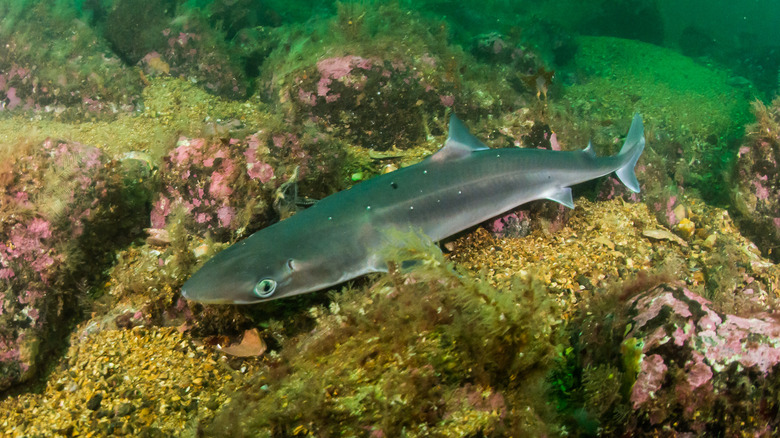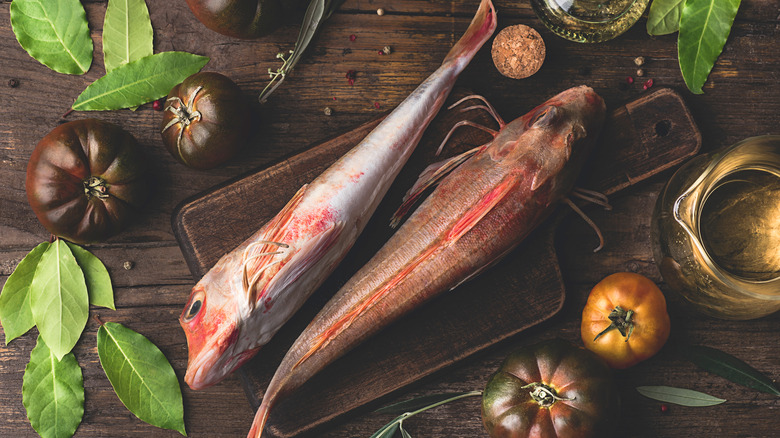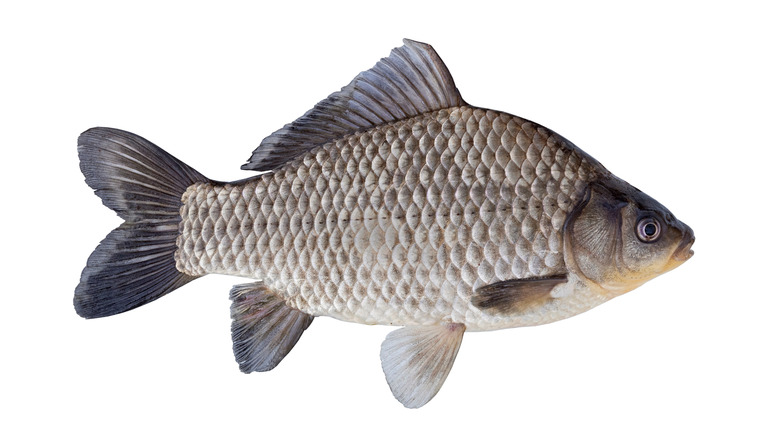12 Underrated Types Of Fish You Should Try At Least Once
By now, the vast majority of people are aware that fish stocks, like many aspects of the natural environment, have been exploited to an unsustainable degree. According to National Geographic, more than a third of fish stocks are experiencing overfishing, creating a pressure on fish populations that is exacerbated by climate change and vice versa (via Greenpeace).
Not all fish are deemed equal, and the most popular fish in the dining room are frequently those most exploited in our oceans. The BBC reports that 80% of the seafood eaten in the U.K. comes from five species. In the United States, 62% comes via just four species. This means that some species, including various types of tuna, are suffering immense challenges posed by chronic overfishing (via Greenpeace).
One way to reduce pressure on these species — while not denying yourself the epicurean pleasures of seafood — is to eat lesser-known, underrated species. As environmental scientist Jessica Gephart explains, it's not like we are limited in our choice: "The category of seafood is really diverse. It includes around 2,500 different species produced by farming and capture fisheries." With this in mind, we have collated a list of 12 underrated but still delicious fish for you to enjoy in the place of more popular species. As with buying any fish, be sure to check the origins and catching method when purchasing to ensure the sustainability of the stocks and fisheries.
1. Sardines
Despite their health benefits, oily fish like sardines are still being overlooked by many consumers (per The Guardian). Sardines are one of the most underrated fish you should be cooking more, argue both doctors, and chefs. Adrienne Cheatham, a "Top Chef" finalist said: "Sardines are really underrated because people are familiar with the flavor from canned sardines and it gets much stronger in the can ... When you have fresh sardines, it's heaven. It's like you get all that healthy fat, you get a little bit of that flavor, but they're so clean, they have just such a different flavor from canned or tin sardines."
As highlighted by The Michelin Guide, sardines are a versatile fish that can play a multitude of roles in the kitchen, from complementing pasta to topping salads. Even the aforementioned canned version can still bring a lot to the kitchen, and canned sardines are one of the healthiest seafood options. But regardless of which types of sardine you buy, the overall consensus is to top the fish with plenty of lemon juice.
Finally, the sustainability of sardines is very dependent on which stock they were sourced from, as per Marine Conservation Society. For example, sardine populations off America's Pacific Coast have suffered a dramatic collapse in recent years (via Oceana), while stocks around the U.K. have been deemed healthy. So, be sure to check for both sourcing location and certification information when purchasing.
2. Red mullet
While white fish have become popular for their distinct lack of flavor (per Dr. Axe), red mullet bucks the trend and is a very flavorful fish (via Great British Chefs). That makes it a much more interesting centerpiece than more celebrated white fish, like cod. This is one of the main reasons that Hung Huynh, executive chef of Catch and "Top Chef" winner, enjoys cooking with red mullet: "I love this fish because it's so sweet and delicate. It tastes like crustacean. It's a small fish that packs in tons of flavor. You need a very precise and delicate hand to cook this fish, as it overcooks and changes flavors depending on the heat." (via Thrillist).
Because it has the more popular, white flesh, red mullet does not have the stigma often heaped upon oily fish. However, cooking it correctly can pose a challenge. The red mullet is prone to overcooking which results in a dry, disappointing end result. When done properly, however, red mullet is flavorsome and fatty without the distinct oily and overly fishy taste present in other species. This makes it a great option for trying a new, underrated species of fish without having to step too far out of your comfort zone.
3. Monkfish
Some things are best left unseen, and a whole monkfish, with its gaping jaws and slimy, swollen tongue, is one of them. Yet, the fish's almost demonic appearance does not alter the fact that it makes a fantastic thing to eat, thanks to both its flavor and firm, meat-like texture (via The New York Times). Due to its inherent structural stability, monkfish tails are often a fish lover's best choice when it comes to alternative cooking methods, such as barbecuing, for reasons Gary Foulkes, executive chef of Michelin-starred seafood restaurant Angler explains: "For me, barbecuing is the best way to cook monkfish. Monkfish tail is brilliant because you can split it into those lovely filets and cook them whole, which results in a better texture and flavor than smaller pieces. If I cook monkfish, I always cook it whole on the barbecue and then slice pieces off." (via Great British Chefs).
Aside from the tail, which bares a striking resemblance to lobster, the lesser known cut of monkfish cheeks is known to be especially delicious, as highlighted by Fresh Fish Daily. These can be cooked in more routine methods, whether shallow fried with garlic and chili, or wrapped in Parma ham or bacon before cooking.
4. Porgy
Porgy, otherwise known as scup, is an inexpensive, relatively small fish that remains a sustainable option for fish caught on America's coastline, as per The New York Times. Startlingly, one of the main reasons attributed to the fish's underrated status is simply the name it is known by. However, once you look past this, you're in for a tasty treat, as Todd Mitgang, executive chef at Crave Fishbar highlights: "Porgy gets a bad rap for a lot of reasons: it's used as bait for bigger fish, and its name doesn't sound particularly classy. Porgy? Scup? I totally understand why this fish gets overlooked, but this needs to end. Porgy is sustainable, and it is fished off of our local coasts. It is sweet, mild, has edible skin that gets nice and crispy, and right now it is more affordable than other varieties that are similar in flavor like red snapper." (via Thrillist).
As explained by Crave Fishbar, porgy can be prepared in a variety of ways, including being roasted whole, fileted and fried, or even transformed into ceviche. As such, it stands as one of the most sustainable and versatile fish available in America right now. And if those aren't great reasons to try this underrated fish, we don't know what will convince you.
5. Mackerel
Somewhat unfairly, mackerel has a reputation for being an extremely fishy mouthful. This, The New York Times reports, is a misconception, with mackerel actually being milder in flavor than salmon. Nonetheless, this commonly held belief has ensured that mackerel has remained largely underrated, as highlighted by Seafood Source. This is a real shame as mackerel is not only a predominately sustainable seafood option (via Marine Conservation Society), but it is also heralded as one of the ocean's healthiest options, as the fish is rich in omega-3 fatty acids and other nutrients like vitamins B2, B3 and B6, as per WebMD.
When it comes to cooking mackerel, most methods are suitable (per Great British Chefs). The fish reacts especially well to intense heat including grilling, barbecuing, and pan frying. When serving and cooking, it is important to remember that mackerel's flavors are well complemented by punchy accompaniments like horseradish, chili, beetroot, and pickled vegetables. It's also delicious roasted whole with lemon, oregano, and olives. All of which means there are near endless ways for you to enjoy this health-boosting little fish.
6. Anchovies
Anchovies are perhaps the most versatile fish in this article, thanks in part to their small size. Anchovies can be used to make flavorful sauces such as pasta puttanesca, while the rich, salty, and umami flavor you get from anchovies also makes them a staple in store-bought sauces like Worcestershire sauce, as per MasterClass. As such, anchovies are a fish that are heavily utilized by foodies and professional chefs alike, with many publications lauding the fish and the unique role it plays in the kitchen (via Woman's World).
The small size of anchovies also makes them a healthy choice, as award-winning chef and restaurateur Seamus Mullen pointed out: "Not only are anchovies a great source of omega-3 fatty acids, because they're so small, they're lower in mercury than bigger fish." (via Well + Good). Furthermore, thanks to the fish being at the bottom of the food chain and the methods used to catch them, anchovies are seen as a relatively sustainable source of seafood when compared to fish at the top of the food chain. This is a fact highlighted by Andy Sharpless, CEO of Oceana: "We can feed tens of millions more people if we simply eat anchovies and other forage fish directly rather than in (the) form of a farmed salmon or other animals raised on fish meal and fish oil." (via The Japan Times).
7. Herring
Herring is a fish that has a long history of being served in a preserved form, whether that be as smoked kippers or pickled herring, which can be quite divisive. The Nosher reports that herring has been a historically popular fish among a variety of European cultures, most notably the Jewish European community which helped introduce the delicacy to the United States. However, despite this long history, herring is frequently overlooked from a culinary perspective due to the fact that it is a relatively small, oily and bony fish (per NPR).
Herring is frequently caught off the coast of California but not for human consumption. Instead, it is mainly used as feed for other animals. This is an unsustainable way of using this natural resource and many, such as Geoff Shester, a director at Oceana, are calling on this practice to change: "We haven't done nearly a good enough job yet of promoting herring as a local, sustainable food source. We live in one of the most progressive, conservation-oriented cities in the country, and virtually no one is utilizing this healthy, sustainable resource that's right in their backyard." The health benefits alluded to by Shester include high concentrations of vitamin D and several, healthy fatty acids (as per The Guardian), making herring a great choice for both our ocean's and our body's health.
8. Smelt
Smelt are another small, thin species of oily fish which many consumers turn their nose up at or remain totally ignorant of. This is a shame, as the seven-to-nine-inch fish is known for both its clean flavor and texture, as per The Globe and Mail. As with many small fish featured in this article, smelt are very versatile. A fact that chef, Eric Lee is keen to point out: "The thing is, smelt is awesome ... mild little fish served dredged and fried with pickled beets or tahini cream: It's hard to beat that. The roe is beautiful and so small and fantastic on sushi, and in other countries they eat the fish with the roe still inside, which seems to me like the best surprise a chef can give you. Smelt fries with Old Bay aioli should be the natural choice at every crab shack from Maine to San Diego." (via Thrillist).
Seafood Source reports that there are nine distinct species of smelt that can be found across North America. Unfortunately, a number of these smelt species have suffered serious population decline in recent years. These include smelt found in places such as California (via The Guardian) and Michigan, as per Michigan Radio. Consequently, it is vital that you check the sustainability of the stock you are purchasing your smelt from, lest you contribute to the pressuring of an already dwindling stock.
9. Dogfish
Actually a species of shark, dogfish is a contentious animal when it comes to fishing, with many news outlets reporting that dogfish are endangered in Europe (via The Guardian). However, spiny dogfish caught in fisheries off the Atlantic coast of the United States are deemed sustainable by organizations such as National Oceanic and Atmospheric Administration. Consequently, those Americans with access to dogfish caught in these fisheries are encouraged to enjoy this delicacy.
Aside from supporting local fishermen, increased domestic consumption is also seen as one way to reduce the American dependence on imported seafood products, a reliance that has been well documented for both its illogical nature and potentially harmful impacts, as per The New York Times. As NPR reports, dogfish is the perfect species to consume if you're looking to eat locally-caught fish. What's more, your taste buds will thank you: Dogfish is known for being an excellent fish to batter and fry, largely due to its meaty texture and ability to stay moist during cooking (via Eat).
10. Lingcod
While the rampant overfishing of cod has been well documented (via Conservation Law Foundation), this shouldn't prevent you from consuming lingcod, due to the simple fact that the fish, despite its name, is not a cod but a greenling. That being said, lingcod have been overfished in the past, most notably during the late 19th century. Yet populations off the West Coast of America are now deemed both stable and sustainable, as reported by Oceana. In fact, Monterey Bay Aquarium highlights that the use of trawling to catch lingcod is the only thing that limits the fish's sustainability status: This being for the simple fact that trawling can cause catastrophic damage to habitats. As such, consumers seeking the most sustainable option should take care to source lingcod that is caught by alternative means.
In the kitchen, lingcod ticks a lot of the boxes consumers are looking for in a fish. It has a classic, flaky texture, the robustness of which makes it suitable for several popular cooking methods, including pan frying. Furthermore, the fish's mild taste means it has a broad appeal, as per The Seattle Times. In short, lingcod is a sustainable substitute for many of America's favorite fishes, and as such should be used in an attempt to protect species, such as cod, from further overfishing.
11. Gurnard
As reported by Britannica, the gurnard is a type of fish found in seas around the globe. In Britain, it was long overlooked for human consumption and was traditionally used as a bait fish for lobster potting, as per The Independent. However, thanks to a range of celebrity chefs using gurnard in various dishes, the fish enjoyed a boost in popularity. But it's still yet to become a classic menu item.
This is a shame as gurnard offers a firm flesh that holds up well in dishes that have long cooking times, such as stews (via Great British Chefs). This, when coupled with the fish's extremely mild flavor, makes it a great choice for dishes where the fish need not be the star ingredient. If seeking a great dinner party entree, try roasting a whole gurnard for each diner. This is a cooking method that makes a delicious dish, and gives people the chance to appreciate its unique appearance.
12. Carp/Copi
It is quite a rare thing when eating fish can benefit, instead of damage, local marine ecosystems. But when it comes to copi — another name for carp — this is exactly the case. As an invasive species, copi is having a number of damaging impacts on the United States' rivers and waterways, as per Smithsonian Magazine. This is largely attributable to the fact that copi are thriving, with huge populations outcompeting native species. One sustainable way of reducing the population? Eating copi instead of other, less abundant fish.
When it comes to cooking, copi can be cooked in lots of different ways, a notion explained by corporate executive chef for the Pioneer Tavern Group in Chicago, Brian Jupiter: "Copi is more savory than tilapia, cleaner tasting than catfish and firmer than cod. It's the perfect canvas for creativity — pan fried, steamed, broiled, baked, roasted, or grilled. Copi can be ground for burgers, fish cakes, dumplings and tacos." However, one significant barrier to consumption has been the negative associations American's draw from the term carp. This has inspired numerous organizations to refer to carp in culinary settings as copi (via York Dispatch).
Renaming is an approach that has worked well with various other types of seafood, including calamari (per The New York Times). Many are now hoping that copi has similar success, as an increased market for the fish would not only reduce pressures on other overfished species, but also improve the state of the nation's rivers.
